How many of these do you remember from school? 😀


Highly interesting articles in the journal Science. Last week it reported on how exercise destroys senescent cells in mature adults. This week it reports how this process prolongs youthful health. (Science 16 July, 2021, pg. 281 ff).
Cellular senescence is a phenomenon characterized by the cessation of cell division. In experiments conducted during the early 1960s, Leonard Hayflick and Paul Moorhead observed that normal human fetal fibroblasts in culture reach a maximum of approximately 50 cell population doublings before becoming senescent.
Cell senescence has been attributed to prevention of carcinogenesis, and more recently, aging, development, and tissue repair. Such cells play a role in the aging phenotype, in aging-associated diseases, and in frailty and sarcopenia. In addition, senescent astrocytes and microglia contribute to neurodegeneration.
Senescent cell load and the secretome increase as we age. This drives inflammation, tissue damage, further infection, inflammation-related pathology, and death.
The removal of senescent cells through physical activity such as physical work and exercise appears to reduce inflammation to below the “young” threshold, allowing disease resolution and survival.
So there’s much truth to what Helen Hayes reportedly said: “If you rest, you rust”.


By Sarah Varney, Kaiser Health News August 6, 2020; Photos: Chokniti Khongchum
For a world crippled by the coronavirus, salvation hinges on a vaccine.
But in the United States, where at least 4.6 million people have been infected and nearly 155,000 have died, the promise of that vaccine is hampered by a vexing epidemic that long preceded COVID-19: obesity.
Scientists know that vaccines engineered to protect the public from influenza, hepatitis B, tetanus and rabies can be less effective in obese adults than in the general population, leaving them more vulnerable to infection and illness. There is little reason to believe, obesity researchers say, that COVID-19 vaccines will be any different.

“Will we have a COVID vaccine next year tailored to the obese? No way,” said Raz Shaikh, an associate professor of nutrition at the University of North Carolina-Chapel Hill.
“Will it still work in the obese? Our prediction is no.”
More than 107 million American adults are obese, and their ability to return safely to work, care for their families and resume daily life could be curtailed if the coronavirus vaccine delivers weak immunity for them.
In March, still early in the global pandemic, a little-noticed study from China found that heavier Chinese patients afflicted with COVID-19 were more likely to die than leaner ones, suggesting a perilous future awaited the U.S., whose population is among the heaviest in the world.
And then that future arrived.
As intensive care units in New York, New Jersey and elsewhere filled with patients, the federal Centers for Disease Control and Prevention warned that obese people with a body mass index of 40 or more — known as morbid obesity or about 100 pounds overweight — were among the groups at highest risk of becoming severely ill with COVID-19. About 9% of American adults are in that category.

As weeks passed and a clearer picture of who was being hospitalized came into focus, federal health officials expanded their warning to include people with a body mass index of 30 or more. That vastly expanded the ranks of those considered vulnerable to the most severe cases of infection, to 42.4% of American adults.
Obesity has long been known to be a significant risk factor for death from cardiovascular disease and cancer. But scientists in the emerging field of immunometabolism are finding obesity also interferes with the body’s immune response, putting obese people at greater risk of infection from pathogens such as influenza and the novel coronavirus. In the case of influenza, obesity has emerged as a factor making it more difficult to vaccinate adults against infection. The question is whether that will hold true for COVID-19.
A healthy immune system turns inflammation on and off as needed, calling on white blood cells and sending out proteins to fight infection. Vaccines harness that inflammatory response. But blood tests show that obese people and people with related metabolic risk factors such as high blood pressure and elevated blood sugar levels experience a state of chronic mild inflammation; the inflammation turns on and stays on.
Adipose tissue — or fat — in the belly, the liver and other organs is not inert; it contains specialized cells that send out molecules, like the hormone leptin, that scientists suspect induces this chronic state of inflammation. While the exact biological mechanisms are still being investigated, chronic inflammation seems to interfere with the immune response to vaccines, possibly subjecting obese people to preventable illnesses even after vaccination.
An effective vaccine fuels a controlled burn inside the body, searing into cellular memory a mock invasion that never truly happened.
Evidence that obese people have a blunted response to common vaccines was first observed in 1985 when obese hospital employees who received the hepatitis B vaccine showed a significant decline in protection 11 months later that was not observed in non-obese employees. The finding was replicated in a follow-up study that used longer needles to ensure the vaccine was injected into muscle and not fat.
Researchers found similar problems with the hepatitis A vaccine, and other studies have found significant declines in the antibody protection induced by tetanus and rabies vaccines in obese people.

“Obesity is a serious global problem, and the suboptimal vaccine-induced immune responses observed in the obese population cannot be ignored,” pleaded researchers from the Mayo Clinic’s Vaccine Research Group in a 2015 study published in the journal Vaccine.
Vaccines also are known to be less effective in older adults, which is why those 65 and older receive a supercharged annual influenza vaccine that contains far more flu virus antigens to help juice up their immune response.
By contrast, the diminished protection of the obese population — both adults and children — has been largely ignored.
“I’m not entirely sure why vaccine efficacy in this population hasn’t been more well reported,” said Catherine Andersen, an assistant professor of biology at Fairfield University who studies obesity and metabolic diseases. “It’s a missed opportunity for greater public health intervention.”
In 2017, scientists at UNC-Chapel Hill provided a critical clue about the limitations of the influenza vaccine. In a paper published in the International Journal of Obesity, they showed for the first time that vaccinated obese adults were twice as likely as adults of a healthy weight to develop influenza or flu-like illness.
Curiously, they found that adults with obesity did produce a protective level of antibodies to the influenza vaccine, but they still responded poorly.
“That was the mystery,” said Chad Petit, an influenza virologist at the University of Alabama.
One hypothesis, Petit said, is that obesity may trigger a metabolic dysregulation of T cells, white blood cells critical to the immune response. “It’s not insurmountable,” said Petit, who is researching COVID-19 in obese patients. “We can design better vaccines that might overcome this discrepancy.”
Historically, people with high BMIs often have been excluded from drug trials because they frequently have related chronic conditions that might mask the results. The clinical trials underway to test the safety and efficacy of a coronavirus vaccine do not have a BMI exclusion and will include people with obesity, said Dr. Larry Corey, of the Fred Hutchinson Cancer Research Center, who is overseeing the phase 3 trials sponsored by the National Institutes of Health.
Although trial coordinators are not specifically focused on obesity as a potential complication, Corey said, participants’ BMI will be documented and results evaluated.
Dr. Timothy Garvey, an endocrinologist and director of diabetes research at the University of Alabama, was among those who stressed that, despite the lingering questions, it is still safer for obese people to get vaccinated than not.
“The influenza vaccine still works in patients with obesity, but just not as well,” Garvey said. “We still want them to get vaccinated.”
– 30 –

by Reinhard Kargl
On May 19 / May 20, 1910, Earth passed through the tail of Halley’s Comet with great fanfare.
The event is meaningful to me for two reasons. First, my grandmother told me about it when I was little. She herself was a little girl in 1910, and her memories were not very detailed. But she recalled, as her strongest memory, the general feeling of excitement among the adults around her. Some must have been genuinely panicked, others were probably nervous, and yet others were mocking those who suffered from vivid superstitions.
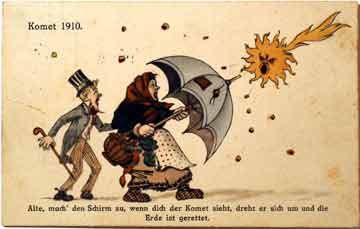
Today, few people know that there was actually another comet visible in the sky earlier that year of 1910. The “Great January Comet of 1910”, officially designated “C/1910 A1” was a surprise visitor in the sky. Already visible to the naked eye when it was first reported on January 12, it brightened very suddenly, to the point where it eventually became brighter than Venus, and was visible during the day.
First spotted in the southern hemisphere, it reached perihelion on January 17 with a magnitude of –5. It then declined in brightness but became a spectacular sight from the northern hemisphere in the evening twilight. By early February, its curved tail reached 50 degrees into the sky.
There were of course plenty of newspaper accounts. The public, not yet accustomed to front page astronomical news, became highly interested in comets, and in what the experts had to say — especially at a time when superstitions and the belief in metaphysics was much more widespread than today.
At the time, Halley’s Comet, which had been known since ancient times, had been calculated to reach its perihelion on April 20, based on Newtonian physics and the work of Edmond Halley.
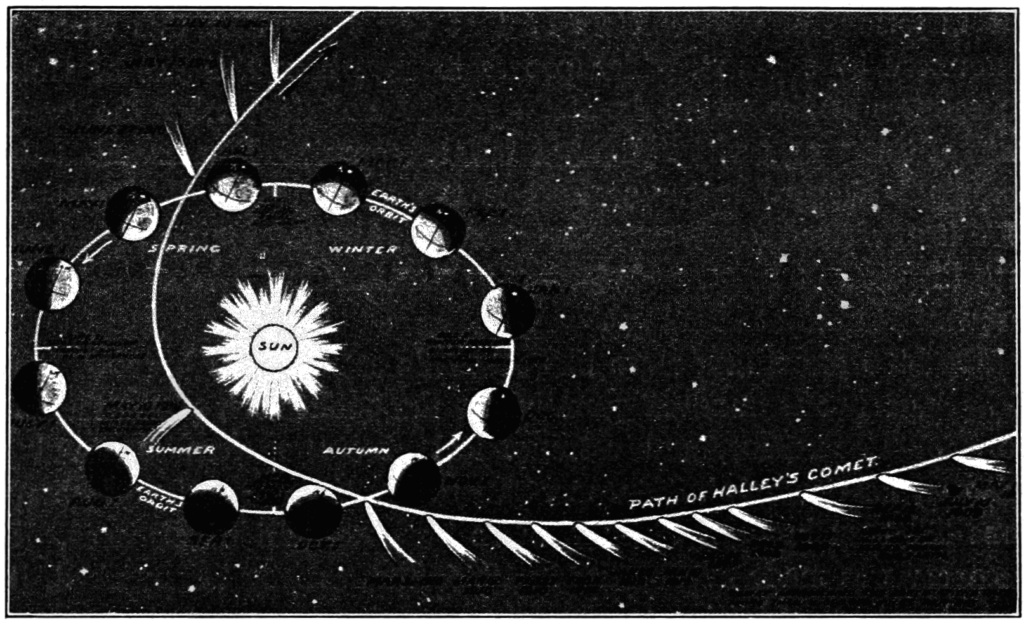
Astrophotography and astrospectography were new fields, they were used to detect toxic gas cyanogen gas in the comet’s tail. The highly famous French astronomer and author Nicolas Camille Flammarion speculated that, when Earth passed through the tail, the poison gas “would impregnate the atmosphere and possibly snuff out all life on the planet.”
Flammarion was not only a genius scientist and author, but also a man with rather esoteric beliefs. He believed not only in the transmigration of souls, but also in telepathy, apparitions, hauntings, and “psychic forces”.
Very quickly, all manner of profiteers, charlatans, mystics, and those purporting to possess special astrological insights, seized on the opportunity, and soon, the panicked public was buying up quack “anti-comet pills”, “anti-comet umbrellas” and gas masks. Sadly, we even find newspaper accounts of people committing suicide because they didn’t want to see the catastrophe.
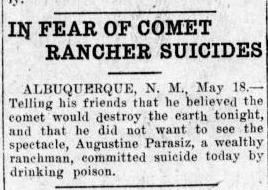
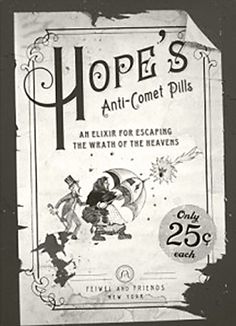
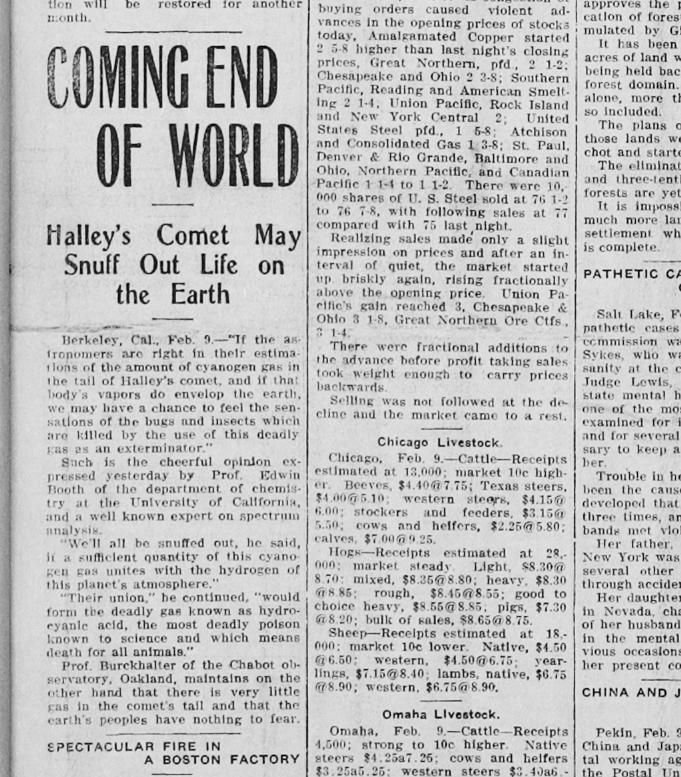
Considering the nature of what left the strongest impression in my grandmother’s memories, I wonder what today’s small children will remember, many decades from now, about the current COVID-19 crisis. Surely, it will be memories about how we adults reacted, which should also give us reason for contemplation.
The other reason why Halley’s Comet interests me is its association with one of my favorite authors and personalities. Mark Twain was born November 30, 1835, exactly two weeks after the comet’s previous perihelion. In his autobiography of 1908, he writes:
I came in with Halley’s comet in 1835. It is coming again next year, and I expect to go out with it. It will be the greatest disappointment of my life if I don’t go out with Halley’s comet. The Almighty has said, no doubt: ‘Now here are these two unaccountable freaks; they came in together, they must go out together.’
Twain died on 21 April 1910, the day following the comet’s subsequent perihelion. This is how the comet looked that day:

– 30 –
by Reinhard Kargl
On March 4, 2018, former Russian intelligence officer Sergei Skripal and his daughter Yulia were poisoned in the English city of Salisbury. Since then, journalists have been scrambling to find out more about the alleged poison, a mysterious substance identified by British authorities as “Novichok”.
First off, it isn’t just one chemical, but appears to be a whole new class of nerve agents, a type of chemical weapons which disrupt the mechanisms by which nerves control vital body functions.
So far, we are familiar with two main classes of nerve agents. The “G-series” was first synthesized by German scientists during World War II. Among this group are tabun, also known as “GA” (invented in 1936), sarin, also known as “GB” (invented in 1939) and soman, also known as “GD” (invented in 1944). (Interesting detail: the Third Reich’s military refused to deploy nerve agents as weapons even though by the end of the war, between 500 kg to 10 tons had been produced. But that’s another story). After the war, GF (cyclosarin) was added to this group in 1949.
The second group, the V-series agents, go back to mostly British development, which was continued with work done the U.S. and the Soviet Union during the Cold War. Members of this class are VE, VG, VM, VR, and VX.
Novichok (Russian: Новичо́к, “newcomer”) seems to be a class of nerve agents different from the two above. It was developed by the Soviet Union during the 1970s and 1980s as part of a secret weapons program reportedly named “Foliant”. The specific intent was to be undetectable by standard NATO methods at the time, to defeat NATO protective gear, and to circumvent the Chemical Weapons Convention list of controlled precursors and classes of chemicals. All in all, over 100 chemical variants were developed and tested.
Most of what little is in the public domain about this can be traced to publications by two Russian chemists, Lev Fedorov and Vil Mirzayanov, writing for the Moskovskiye Novosti weekly in 1992. Mirzayanov claimed he made his disclosure out of environmental concerns, after measuring levels of deadly substances 80 times greater than the maximum safe concentration in the vicinity of Russian chemical weapons facilities. Mirzayanov was arrested in October 1992 and charged with high treason. He served some time in prison, and subsequent to his release, left Russia to live in the U.S. However, during Mirzayanov’s trial, some more details about the Novichok program emerged, and the Russian military was forced to acknowledge the existence of this group of chemicals.
According to Mirzayanov, the most potent compounds from this family, Novichok-5 and Novichok-7, are supposedly around five to eight times more potent than VX. The agents are reportedly capable of being delivered as a liquid, aerosol or gas via a variety of delivery systems, including bombs, missiles, artillery shells and spraying devices.
The absorption of nerve agents into the human body can be by skin contact, ingestion, inhalation or injection. Generally speaking, these chemicals were conceptualized as weapons of mass destruction and for wide dispersement. The pin-point use as murder weapons in targeted assassinations appears to have been an afterthought. But it is now well documented in several instances, such as the murders of Russian banker Ivan Kivelidi and his secretary Zara Ismailov in 1995, or the killing of Kim Jong-nam in Malaysia on February 13, 2017. (The U.S. Department of State has claimed the assassination was a plot conducted by agents of North Korea, using VX).
And here it gets extremely troubling. It would appear that nerve agents, due to their rapid effectiveness in extremely small doses, make ideal weapons for assassinations. However, these chemicals require highly specialized skills and facilities to develop, manufacture and deploy – all of which is difficult to conduct except in the presence of state-sponsored weapons programs. Even where chemical weapons treaties led to the controlled and audited destruction of chemical weapons of mass destruction, there can be no doubt that small batches of all these substances were retained, and that of course, the process of making them (even in very small quantities) is well understood by those who were involved in these military weapons programs.
So are we looking at a coming new era of silent state-sponsored assassinations? Could this become a method for governments or institutions to get rid of regime critics, political dissenters or opponents, alleged traitors, whistleblowers and others deemed a threat, on a large scale?
It could well be. The other options – an illicit trade of these substances, or the possibility that criminal organizations, terrorist groups or rogue individuals may have found ways to cook them up in hidden labs – are equally scary.
Either way this will play out, the future on this issue looks gloomy.
According to a friend’s recent social media post, a 15-pound opossum has been caught under her house in the Los Angeles area.
The responses were an interesting, but typical cross section of America’s modern-day urbanites: one well meaning person commented how beneficial opossums were (and listed a whole range of “pest control” supposedly performed by opossums. Another pleaded to have it released alive in some other place “where it could thrive”. Another was concerned about possible “babies somewhere”, and yet another said how sad it was that the opossum “had to leave its home”. One commenter even inquired if the intent of the capture was to keep it as a pet.
I probably should keep my mouth shut, but the science writer (with some academic background in biology) finds this rather difficult.
The reason why I find this interesting is because here is a good illustration of what the relationship with nature has turned into — as least in big cities. On the one hand we engineer completely synthetic environments with a couple of dispersed token shrubs and sad trees, as if to distract from the fact that we have sealed and suffocated most of the natural Earth beneath our feet. On the other hand, we romanticize every critter and think if it’s alive out there somehow, it must be part of nature and thus, it has every right to be here among us. In a strange twist, we humans are suddenly said to be “encroaching” on the territory of beasts, and not the other way around. This, after we have thoroughly destroyed or at least altered almost every natural habitat on Earth – or perhaps because of it.
There are now city slickers in California who are willing to accept the occasional hiker or resident getting killed or maimed by a bear or mountain lion as if this was just an unfortunate but rare and unavoidable accident. I have even seen bizarre comments not suggesting, but proclaiming it was the home owner’s or hiker’s fault for “being in the animal’s habitat”. “Leave the animals alone,” suggested one. “Nobody needs to live there. Nobody needs to go hiking in the backcountry. That’s why we have gyms.”
People have started to perceive wilderness as if it was just the no-go section of Disneyland, the wild animal zone of the park into which humans should only be allowed with severe restrictions and at their own peril — after obtaining a permit and signing liability waiver and consent forms. And the anthropomorphic worldview of children has not just become mainstream — it is now considered the new normal. This extends also to how mainstream America treats its pets, which, or who, as some have suggested, should be given civil rights independent from their owners.
But back to opossums. What does science really tell us about them?
Being the largest order of marsupials in the Western Hemisphere, they are comprised of 103 or more species in 19 genera. None of them is native to California.
As far as wildlife zoologists can tell, they were introduced in San Jose in 1910 from the East Coast. They are an invasive species and therefore not well suited to live in the California wilderness at all. Outside of their natural habitat, they are opportunists thriving in or near human habitation, which they exploit.
The myth that opossums have all these wonderful benefits is greatly exaggerated, and some of these claims are simply false. Some are a mix of fact and fiction. For example, the immune system of opossums is quite remarkable. They seem to have immunity to many snake venoms, which is a topic of scientific inquiry as it may help us to make better anti-venom for victims of snake bites. Opossums also possess a high degree of natural immunity to the rabies virus. While all this is scientifically very interesting, it is incorrect to assume that the presence of opossums will rid the neighborhood of dangerous  snakes.
snakes.
Opossums pose a threat to both wildlife outside their natural habitat, and to domestic pets. In California, the purported benefits of opossums could be had with native animals such as raccoons and skunks, on whose territory opossums encroach.
The University of California’s Integrated Pest Management Program has this to say:
“Opossums are considered a nuisance in gardens and near homes where they feed on berries, grapes, tree fruits and nuts, and defecate on garden paths and patios. They get into fights with dogs and cats and can inflict serious injury with their mouthful of sharp pointed teeth.
Opossums carry diseases such as leptospirosis, tuberculosis, relapsing fever, tularemia, spotted fever, toxoplasmosis, coccidiosis, trichomoniasis, and Chagas disease. They may also be infested with fleas, ticks, mites, and lice. Opossums are hosts for cat and dog fleas, especially in urban environments. This flea infestation on opossums is particularly concerning for transmission of flea-borne typhus, which is increasing in prevalence in Orange and Los Angeles Counties.”
So there you have the scientific truth.
It should be noted that it is illegal to relocate an opossum without a permit. For two reasons: (1) It has virtually no chance of surviving in the California wilderness, but it might introduce new diseases and parasites acquired near humans and from their pets, to wild animals. (2) It can only thrive by scavenging from human habitation, and releasing a captured opossum near someone’s else’s home amounts to gifting the problem to someone else.
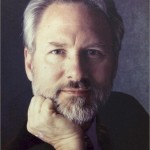 What is the maximum human lifespan? Why do we age? What are the causes and their mechanisms? Why do humans tend to live longer than most other mammals? Do we have a built-in “expiration date” – perhaps for the benefit of the species? Can the aging mechanism be delayed or entirely deactivated leading to eternal life?
What is the maximum human lifespan? Why do we age? What are the causes and their mechanisms? Why do humans tend to live longer than most other mammals? Do we have a built-in “expiration date” – perhaps for the benefit of the species? Can the aging mechanism be delayed or entirely deactivated leading to eternal life?
These and the related questions were what fascinated Dr. L. Stephen Coles, who in 1990 founded the Los Angeles Gerontology Research Group, a global network of researchers and parties intrigued by the boundaries of the human life span. Among the group’s primary work is the cataloguing, tracking and studying of so-called “supercentenarians” – people who live past the age of 110. (As of this writing, there are only 76 such humans verified to be living on this planet. 74 of them are women).
I became intrigued with this subject after reading about Dr. Coles’ work in this Los Angeles Times article in 2004. So I got in touch with him and found a fascinating researcher, inspiring person and mentor.
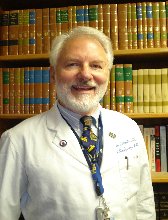
Subsequently, I wrote a long-form magazine article on the subject, which was published in a German science magazine. Dr. Coles was the most important and primary source for it. During the many hours we spent talking, I learned to appreciate not only his professional knowledge, but also his humor, gregarious personality and boundless enthusiasm for the hope that science would, very soon, make it possible for humans to live exceedingly longer than today.
Steve was a passionate proponent of evidence-based science and rational thought, for the prosperity of all mankind. Sadly, he didn’t get to benefit from the future scientific breakthroughs he was hoping for. I was shocked when shortly after Christmas of 2012, there came an e-mail announcing this Steve’s holidays had been rather miserable.
“I am sad to report that on Christmas Eve (two days ago), I received the
horrible diagnosis of ‘adenocarcinoma of the head of the pancreas’,” the message read. “BTW, this is the same form of cancer that Steve Jobs CEO of Apple Computer had before he passed away when money was no object. Although I knew that something was wrong with my body for the last three weeks (acute onset of symptoms with the occult tumor possibly growing subclinically for two years or more with no manifestation of its presence until it grew large enough to screw up my internal plumbing by its sheer volume [about the size of a plum])”.
Knowing that pancreatic cancer has one of the lowest survival rates of all carcinomas, the first thing that came to my mind was obvious. It was really crushing.
Of course Steve was perfectly aware of his low odds. He went on writing, “Even in the best of all possible worlds, the mortality statistics after five years of chemo therapy are not great (around 50 percent). Of course, in the event of metastases, one’s life post chemotherapy/radiotherapy are significantly shortened proportionally.”
And unfortunately, there was metastasis in the liver.
Various attempts were made – first surgery (the “Whipple Procedure“), then various chemotherapy, as well as some experimental procedures involving the growth of tumor-specific cells in the laboratory.
While the procedures prolonged Steve’s life to the limits of the statistical prognosis range, they failed in in the end.
When this final message on Oct. 9, 2014, we all knew this was it. “Update on Health Status,” it said. “In order to be eligible for more services, last week I was placed on hospice care at home. Now that I have been taken off taxotere, some measures of health have improved. However, my eligibility for the ECLIPSE clinical trial has been placed on hold pending a decrease in frailty.”
Steve passed away on December 3, 2014, a few weeks short of living for two years after his diagnosis.
But the story does not end here. A few days before his death, Steve must have gone on his life’s final journey: From Los Angeles to Scottsdale, Arizona. Located there is the Alcor Life Extension Foundation – coincidentally also an organization which intrigues me, and about which I have also reported in detail.
Alcor is the leader in “cryonics”. This is an experimental technology which seeks to preserve human bodies through a procedure resulting in suspension of human tissues in liquid nitrogen, at extremely low temperatures, in perpetuity. The hope is that one day in the future, biotechnology will exist to revive these cryogenically “suspended” human bodies, restore them to life by the use of sophisticated nanotechnology, and also deal with whatever the cause of death was.
Depending on the preferences of the customer, either the entire body, the head or just the brain may be frozen (on the theory that once biotechnology has progressed far enough, it should also be possible to either create a new body, or transfer the brain’s content into a computer system).
I am not at all surprised that Steve was also intrigued by the idea and made arrangements to implement this option as a last resort.
And so, Steve’s brain will come to rest in a dewar of liquid nitrogen. Perhaps, one day, he might live again. And he has reportedly made a reservation to attend his colleague Johnny Adams’ 100th birthday party. In the year of 2049.
I will miss him.
Obituary in the Los Angeles Times
 I recently wrote a feature story about the many uses of unmanned aerial vehicles (“drones”). It was published in February 2011 issue of the German Gruner+Jahr publication, Wunderwelt Wissen.
I recently wrote a feature story about the many uses of unmanned aerial vehicles (“drones”). It was published in February 2011 issue of the German Gruner+Jahr publication, Wunderwelt Wissen.
I truly believe that drones will revolutionize law enforcement, border patrol, search and rescue, security, agriculture, environmental monitoring, fire fighting, traffic control and many other areas.
Here is a good example for what drones can do. Flying over the Fukushima reactors is very dangerous at this time. Not only because of the direct radiation, but also because radioactive particles can get sucked into aircraft. Unmanned drones, on the other hand, can fly very close and and provide images and measurements around the clock. Some can even hover in the air and get within a few meters of parts to be inspected.
Here are a few aerial shots.
This Sunday we will again do the crazy switch: “Daylight Savings Time”. But the assertion that Daylight “Saving” Time “saves” energy is bunk. It is simply a stupid and anachronistic idea. It serves no documentable purpose and should be done away with.
Not only have the positive effects of DST never been conclusively documented. On the contrary! In recent years, there has been a growing body of scientific evidence showing an increase in energy consumption during DST.
The idea behind DST was that more daylight in the afternoon would reduce the need for artificial lighting, thus cutting down on energy costs.
But as it turns out, more light (and heat) in the afternoon also means an increased demand for air conditioning, which results in a net increase in energy usage. These are the findings of a 2008 study by two University of California, Santa Barbara researchers. “I’ve never had a paper with such a clear and unambiguous finding as this,” said lead researcher Matthew Kotchen.
Studies conducted in Japan, Australia and the State of Indiana have reached similar conclusions.
In the U.S., the situation is rather bizarre: some states switch to DST, others don’t. In the State of Indiana, some counties have DST. Others don’t. So if one drives though the state, the time jumps!
There is similar confusion around the globe. Some countries switch to DST, others don’t. Some (just to top everyone else in terms of absurdity) switch only one half hour forward and back.
Here is a world map showing DST usage:

Legend: DST implemented (blue), DST not implemented (red), DST formerly used but now abolished (orange). Click to enlarge.
Of course, this impacts telecommunications, the travel industry, navigation and international business.
It is idiotic (to say the least!).
By the way: another false myth about DST is that Benjamin Franklin suggested it. Not true! Franklin merely suggested that getting up earlier (with the sun) and going to bed earlier would be more efficient – considering that most illumination in his days came from (expensive) candles and oil lamps.
Franklin is said to have remarked: “Early to bed, and early to rise, makes a man healthy, wealthy and wise”. In 1784, he also published an anonymous letter, which satirically suggested taxing shutters, rationing candles, and waking the public by ringing church bells and firing cannons at sunrise. Of course he was not serious. And he never suggested to move the clocks back and forth.
Here is an organization with the goal of abolishing DST for good: http://www.standardtime.com/
(Adapted from my blog post of 03/07, 2008)